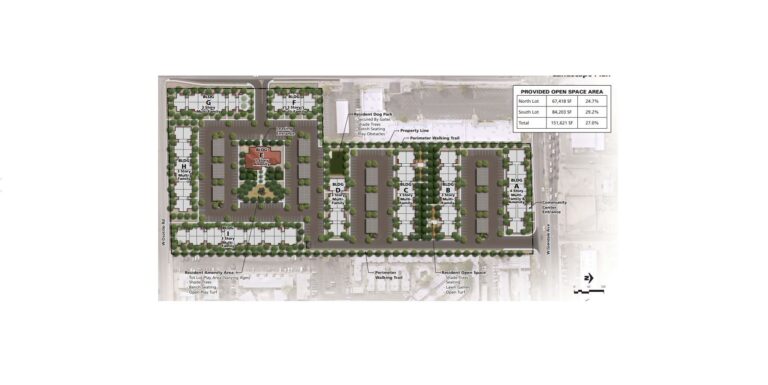
By Roland Murphy for AZBEX
A recent proposal by Gorman & Company, Inc. will, if built according to plan, produce 368 units of affordable housing at 6529 W. Glendale Ave. in Glendale.
Centerline on Glendale is planned for 12.9 acres. The project will consist of eight three- and four-story buildings with 170 one-bedroom, 154 two-bedroom and 44 three-bedroom units.
According to the materials submitted to the City of Glendale, the site will include a one-story amenity building in the center of the development with a community room, leasing office, outdoor splash pad and a playground space. Resident services will include general retail offerings, community facility services and, possibly, some medical and healthy food options.
Gorman has requested a minor general plan amendment and rezoning for the project. The Glendale Planning Commission heard the proposal in its March 24th meeting, but results were not posted by press time. The request is scheduled to go before the Glendale City Council on April 26th.
The company has submitted a request to the Arizona Department of Housing seeking Low-Income Housing Tax Credits in the amount of $2M. For application purposes, the request divides the project in two: Centerline on Glendale I (186 units) and Centerline on Glendale II (182 units). The requests before the City do not note the project will consist of multiple phases.
Gorman & Company projects target revitalization and neighborhood development, according to the company website, with a portfolio of developments in Arizona, Illinois, Wisconsin and Colorado. Gorman has seven projects in active development around Arizona and has completed nine others in the state since 2016.
An Arizona Affordable Housing Snapshot
In acknowledgement of April’s status as National Fair Housing Month, we decided to put together a brief overview of affordable housing in the Arizona.
While all new residential deliveries, no matter the price point, contribute to affordability by adding supply to meet the state’s voracious demand, more than 90% of multifamily units in the Arizona development pipeline now and for at least the last five years have been produced for the top two tiers of the market-rate sector, according to 2021 information from Colliers in Arizona.
The Phoenix and Tucson metro areas, obviously, make up the vast majority of development projects in the state. According to information from Yardi Matrix, those two markets delivered a combined total of 11,073 units across 58 projects in 2021. Basic demand projections put a conservative needed annual delivery count at between 15,000 and 17,000 multifamily units to meet 2017 demand levels by 2030. The Arizona Housing Authority has set its needed unit estimate at 270,000 for all housing types to meet 2030 needs.
A look at the DATABEX project database shows a total of 44 projects referencing affordable housing. These are not distinguished between projects that are designated/dedicated as income-restricted and those where affordability, particularly workforce affordability, is merely a stated goal of the developer.
The 44 multifamily projects found under a keyword search of “affordable” comprise a total of 6,179 units. Of those, a deeper, a per-project description examination shows 3,991 units specifically targeting an affordable unit goal.
While the list is not exhaustive or complete for the state by any means (Many projects are too small to make the $5M DATABEX cutoff; some have not yet gone far enough into the planning process to have unit counts available, etc.) it is, nonetheless, sobering to see that the total volume of units in which the word “affordable” is included in the project description since 2016 totals fewer than 56% of the unit volume delivered last year.
Readers should note the Editorial and Research teams have started a review of housing programs around the state to examine goals and processes and to evaluate their potential impacts. Look for our summary report coming in AZBEX later this month.

